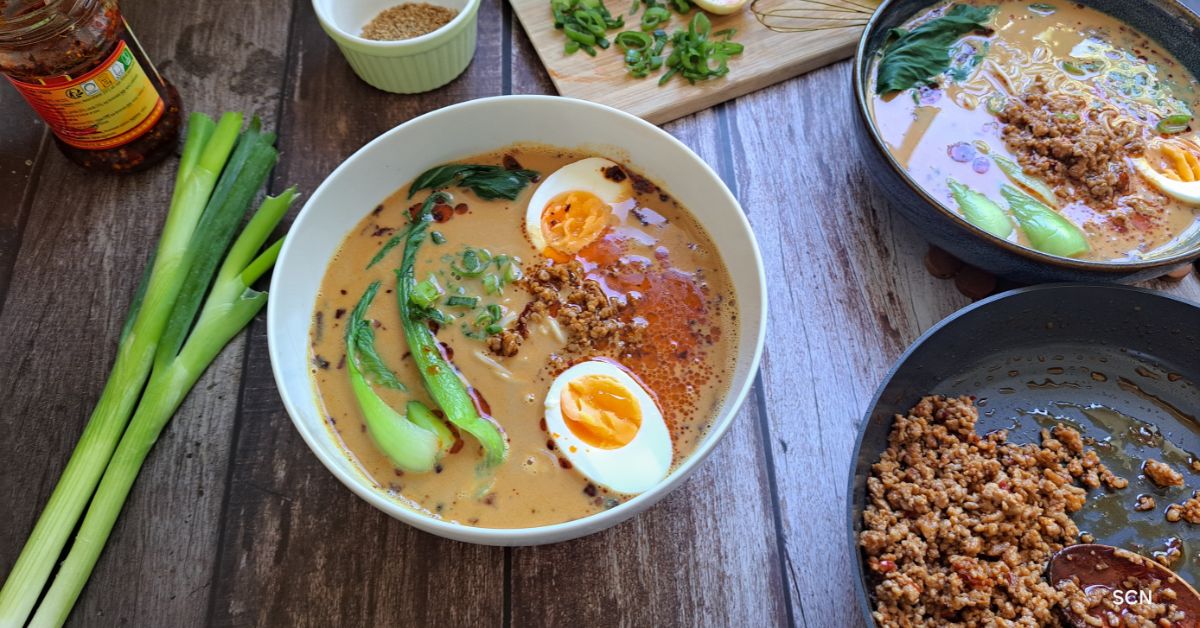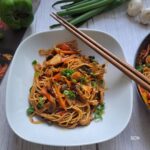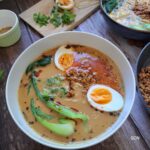Tantanmen Ramen

Tantanmen Ramen is a warm, spicy, and creamy Japanese noodle soup. It is inspired by a Chinese dish called Dan Dan Noodles. The Japanese version is less oily and often has a creamier broth. It uses ingredients like sesame paste, soy milk, and chili oil to create a rich, flavourful base. Here’s a restaurant-style recipe you can make at home — and yes, pak choi is often included! Tantanmen is known for its balance of spice, umami, and creaminess.
A Flavourful Broth
The heart of Tantanmen is its broth. It is made with chicken stock and unsweetened soy milk. The soy milk makes the broth creamy without using any dairy. Sesame paste (or peanut butter) adds a deep, nutty flavor. Chili oil, soy sauce, rice vinegar, and a bit of sugar bring the rest of the taste together. The result is a soup that is spicy, slightly tangy, and very satisfying.
Toppings
One of the key parts of Tantanmen is the spicy ground meat on top. Cook the minced meat (pork or chicken) with garlic, soy sauce, mirin, and Gochujang or doubanjiang (spicy bean paste). The meat adds a nice bite to the dish. It also mixes into the broth as you eat, making every spoonful more delicious.
Tantanmen is served with ramen noodles. You can use fresh or dried noodles. They should be cooked just right—not too soft. Along with noodles, you can add leafy greens like spinach or Pak choy. A soft-boiled egg is a common topping and adds creaminess. For extra flavour and texture, add green onions and toasted sesame seeds on top.
Doubanjiang
Doubanjiang is a spicy, salty paste made from fermented broad beans, soybeans, salt, rice, and chili peppers. It is a key ingredient in Sichuan cuisine, often called the “soul” of many dishes. The paste has a deep, rich flavor and a strong umami taste. People use it to make mapo tofu, stir-fries, and hot pot. There are different types, from mild to very spicy. The most famous doubanjiang comes from Pixian, a town in Sichuan, China. It is aged for months or even years to develop its bold flavour.
Here are some common alternate ingredients you can use for Tantan Ramen if you don’t have the originals:
- Doubanjiang → Gochujang (Korean chili paste): It’s sweeter and less fermented, but still adds spice and depth.
- Chinese sesame paste → Peanut butter: Use unsweetened, smooth peanut butter for a creamy texture and nutty taste.
- Chili oil → Sriracha or spicy sesame oil: Adds heat and aroma, though with a slightly different flavour.
- Ground pork → Ground chicken, beef, or tofu: Adjust seasoning for flavour.
- Rice vinegar → Apple cider vinegar or lime juice: For a little acidity.
Easy to Customize
Tantanmen Ramen is easy to make your own. If you don’t eat meat, you can use tofu or mushrooms instead. If you like it less spicy, just reduce the amount of chili oil or Gochujang. You can also add other toppings like corn, bean sprouts, or seaweed. It’s a fun dish to personalize based on what you like.
A Comforting Meal
Tantanmen is not just delicious—it’s also comforting. The warm broth and soft noodles make it perfect for cold days or whenever you want a cozy meal. It’s easy enough to cook at home and tastes just as good as a restaurant bowl.
Tantanmen Ramen is a wonderful mix of Japanese and Chinese flavours. With just a few ingredients, you can make a bowl that’s both comforting and exciting. Whether you’re new to Japanese cooking or already love ramen, Tantanmen is a dish worth trying.




Tantanmen Ramen
Ingredients
For the meat
- 225 grams of ground pork or chicken
- 1 tbsp sesame oil
- 2 cloves of garlic
- 1 tbsp mirin
- ½ tbsp soy sauce
- 1 tbsp Doubanjiang (chilli bean paste) or substitute with Gochujang
For the soup base
- 2 cups chicken stock see notes
- 2 cups unsweetened soy milk
For the flavour base (Serves two bowls)
- 1 tbsp light soy sauce
- 1 tbsp dark soy sauce
- 2 tbsps Chinese Sesame paste, or substitute with peanut butter
- 1 tsp rice vinegar
- ½ tsp sugar
- 1 tbsp Chilli oil
Noodles and toppings
- Fresh or dried ramen noodles
- 2 handfuls leafy greens such as spinach, Pak choy, trimmed and washed
- Soft-boiled eggs optional
- Green onions chopped
- Toasted sesame seeds
Instructions
Cook the Pork
- Heat a pan over medium heat and add sesame oil. Add the minced garlic and saute until golden brown.
- Add the minced pork and cook until browned and no longer pink.
- Stir in the mirin, soy sauce, and gochujang or doubanjiang. Cook for another 2-3 minutes until fragrant and the pork is well-coated. Set aside.
Make the Soup Base
- Gently heat the chicken broth + soy milk mixture in a pot — do not boil (to prevent soy milk from curdling).
- Keep warm over low heat.
Cook the Noodles and Greens
- Bring a large pot of water to a boil.
- To the pot of boiling water, add the green vegetables and blanch for 30 seconds to 1 minute. Remove from the water, drain, and set aside.
- Bring the water to a rolling boil again, and add the noodles, cooking them according to package directions until they’re just cooked through and still chewy.
- Drain the noodles and set aside.
Prepare the flavour base
- Put all the ingredients of flavour base into a bowl. Mix well to form a smooth paste or sauce.
Assemble the Bowls
- Divide the flavour base into your two empty ramen bowls.
- Pour in hot broth (about 1½–2 cups of soy milk + chicken broth combo).
- Stir well to emulsify into a rich, creamy soup base.
- Divide the noodles among serving bowls.
- Top with spicy pork, pak choi, soft-boiled egg, green onions, and sesame seeds.
- Top with the seasoned pork.
- Optional: Garnish with sliced green onions, extra chilli oil, or toasted sesame seeds.
Notes
Frequently Asked Questions
Tantanmen is the Japanese adaptation of the Chinese Sichuan dish Dan Dan Noodles. It features a creamy, spicy broth made with sesame paste, soy milk, and chili oil, topped with spicy ground meat, noodles, and optional toppings like greens and soft-boiled eggs.
It is moderately spiced. But you can adjust the spice level to your preference by reducing or omitting ingredients like Gochujang, doubanjiang, or chili oil.
Absolutely! Substitute:
Ground meat with tofu crumbles, mushrooms, or plant-based meat
Chicken stock with vegetable broth
Ensure your chili paste and soy milk are vegan-friendly
Use fresh or dried ramen noodles. If unavailable, you can substitute with:
Udon
Soba
Instant ramen (discard the flavour packet)
Yes, creamy peanut butter works well if you don’t have sesame paste or tahini. The flavour will be slightly sweeter, but still delicious.
Boiling soy milk can cause it to split or curdle. To avoid this:
Use unsweetened soy milk
Heat the soup gently and do not let it boil
Add a splash of broth to the soy milk first to temper it before combining fully
Yes! You can make the flavour base and soup base up to 2–3 days in advance. Store separately in airtight containers in the fridge. Reheat gently before serving.
Noodles: Best cooked fresh. If storing, keep them separate from the broth to prevent sogginess.
Broth and meat: Store in airtight containers in the fridge for up to 3 days or freeze for up to 1 month.
It’s not recommended. Soy milk adds a nutty, creamy flavour that complements the sesame and spice. Dairy can curdle or taste too rich/heavy. If needed, use unsweetened almond or oat milk instead.
Share Your Creations and Connect with Me on Social Media!
Have you tried this recipe? Don’t forget to tag me with your pictures on Instagram – I love to see your creations! 💕 Also, be sure to comment and rate below! Follow me on social media:
1 thought on “Tantanmen Ramen”